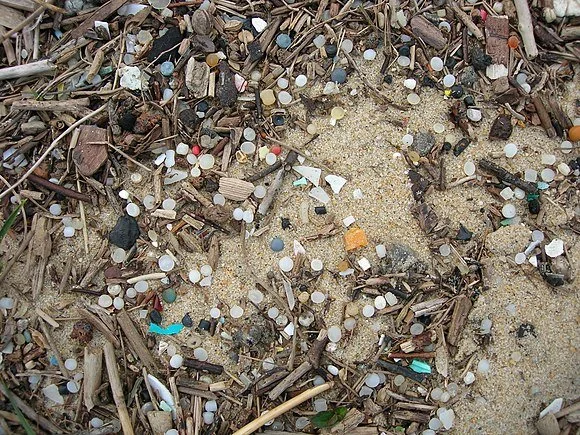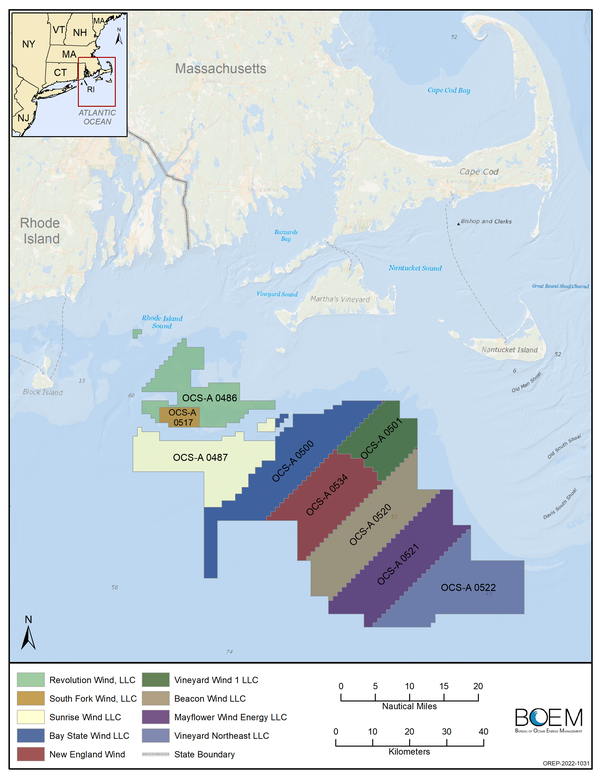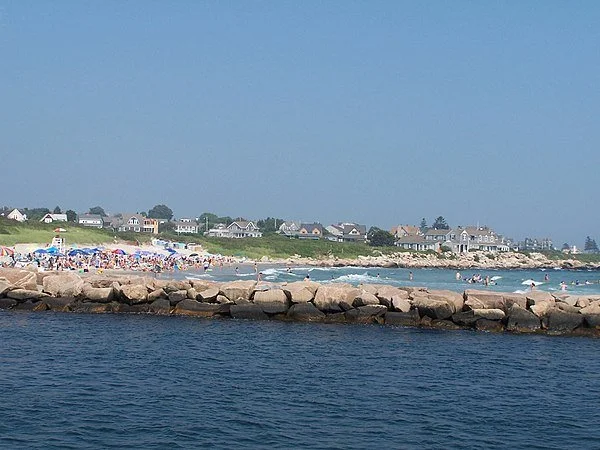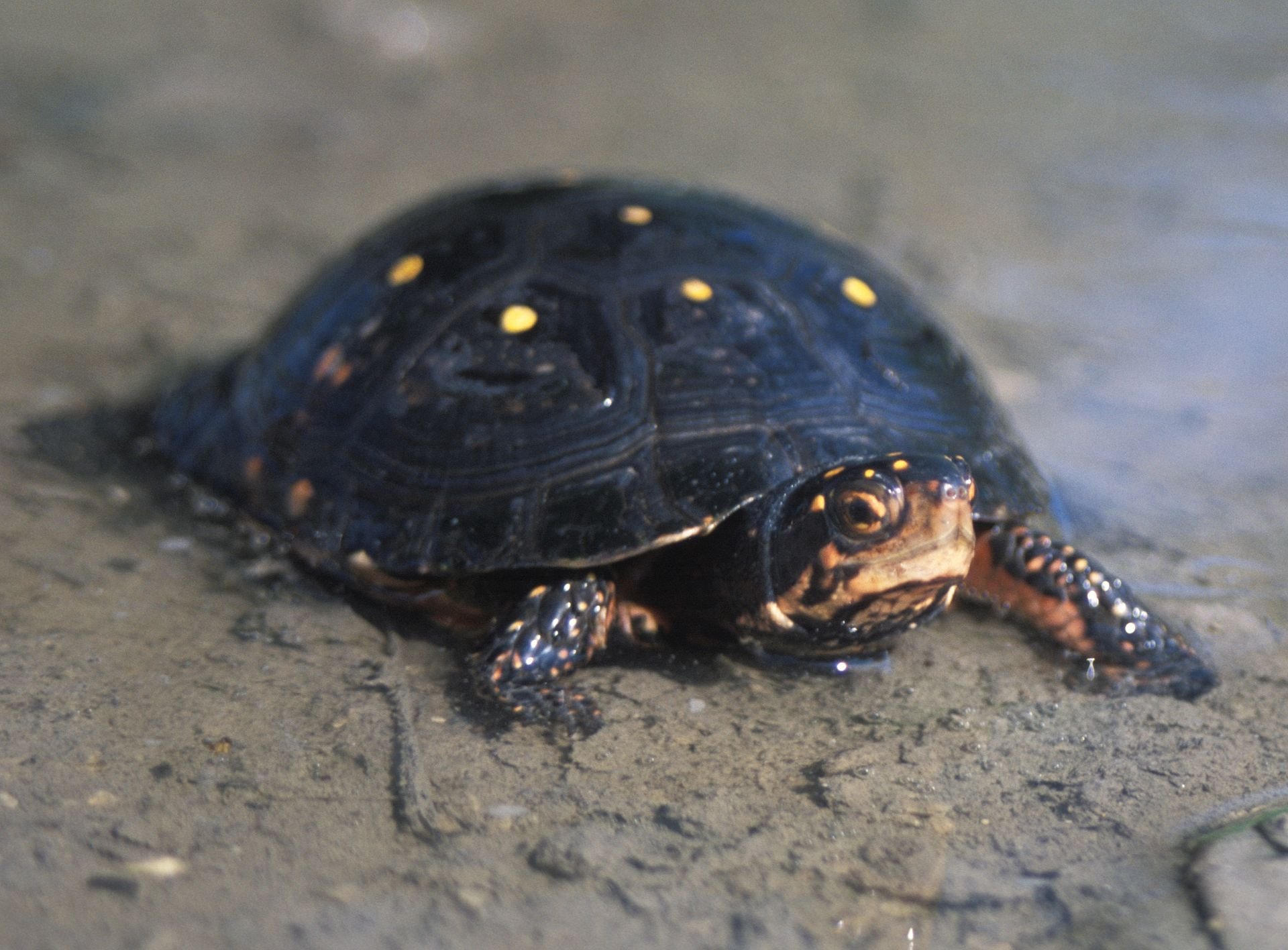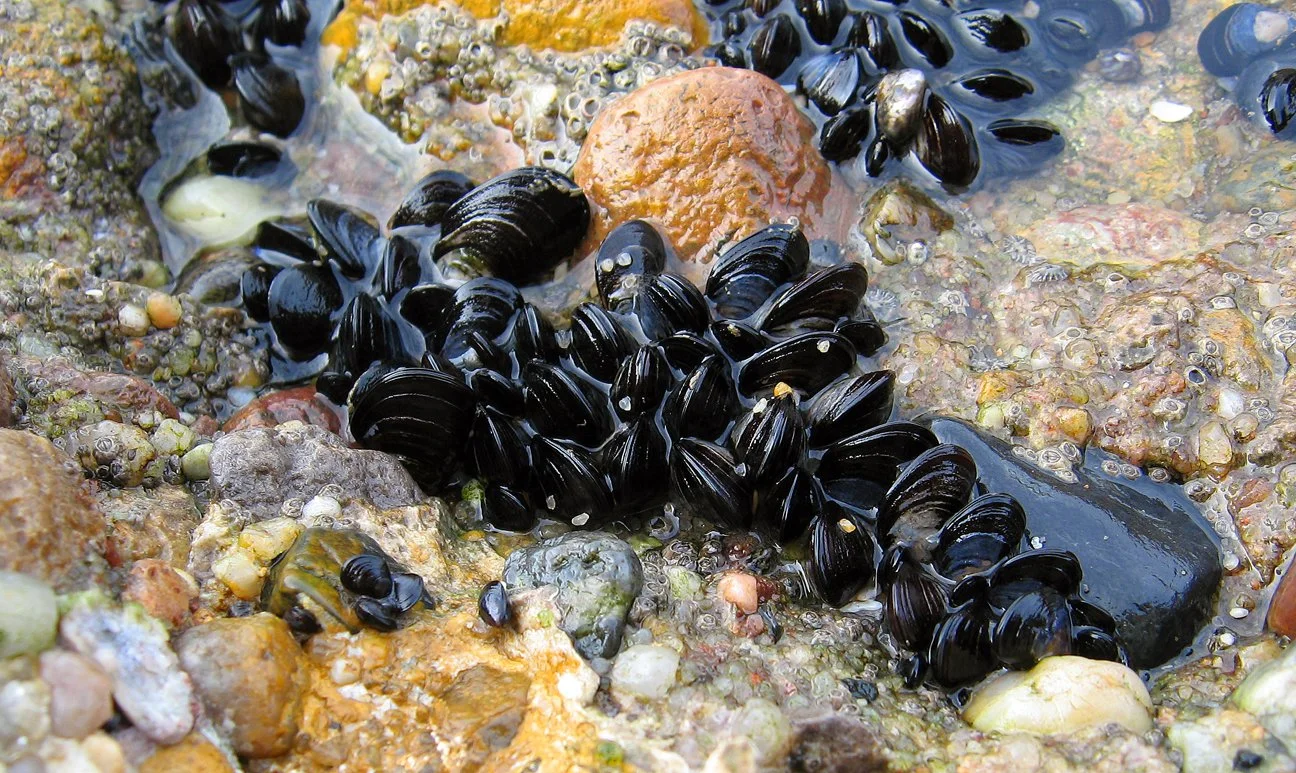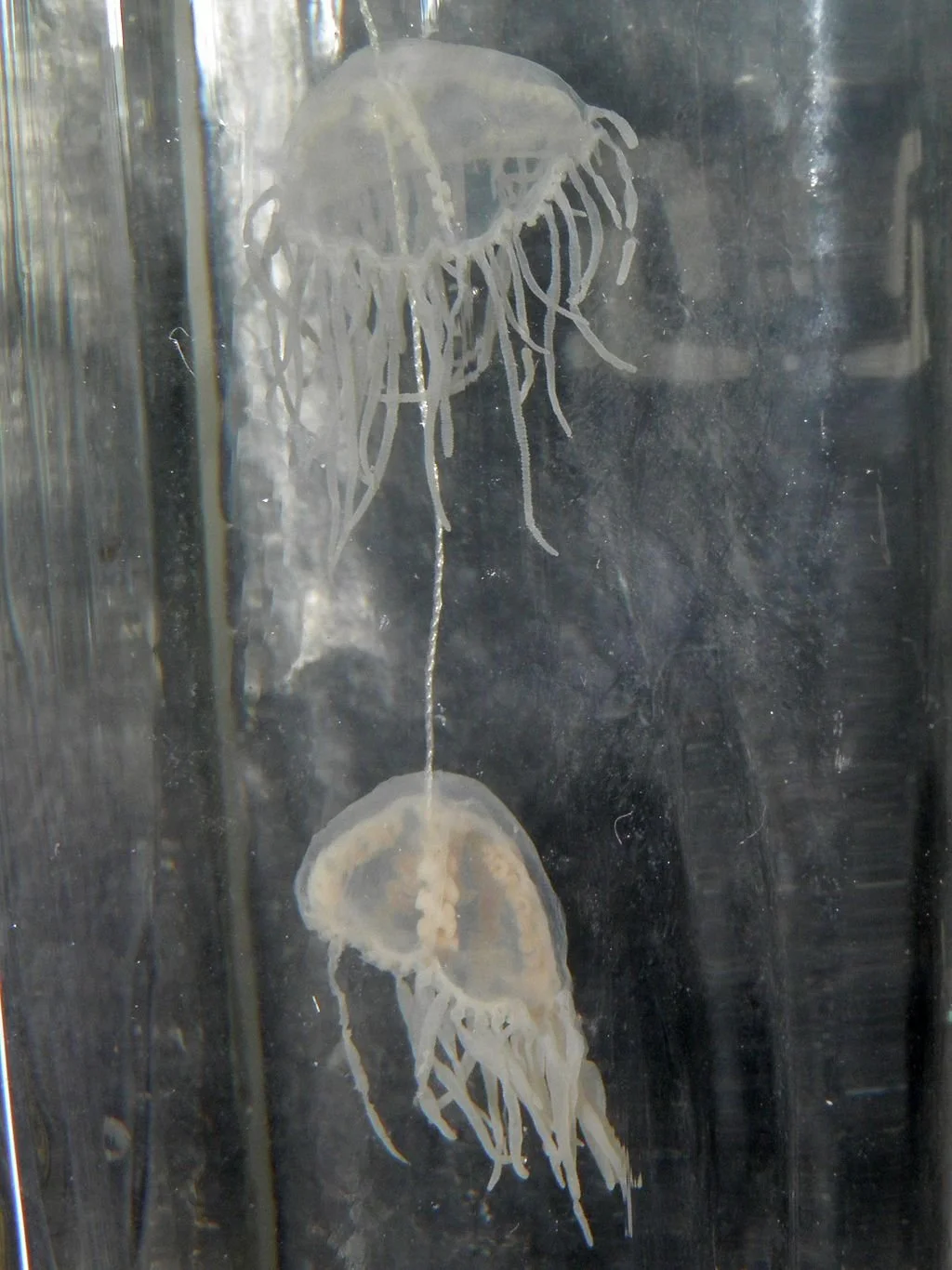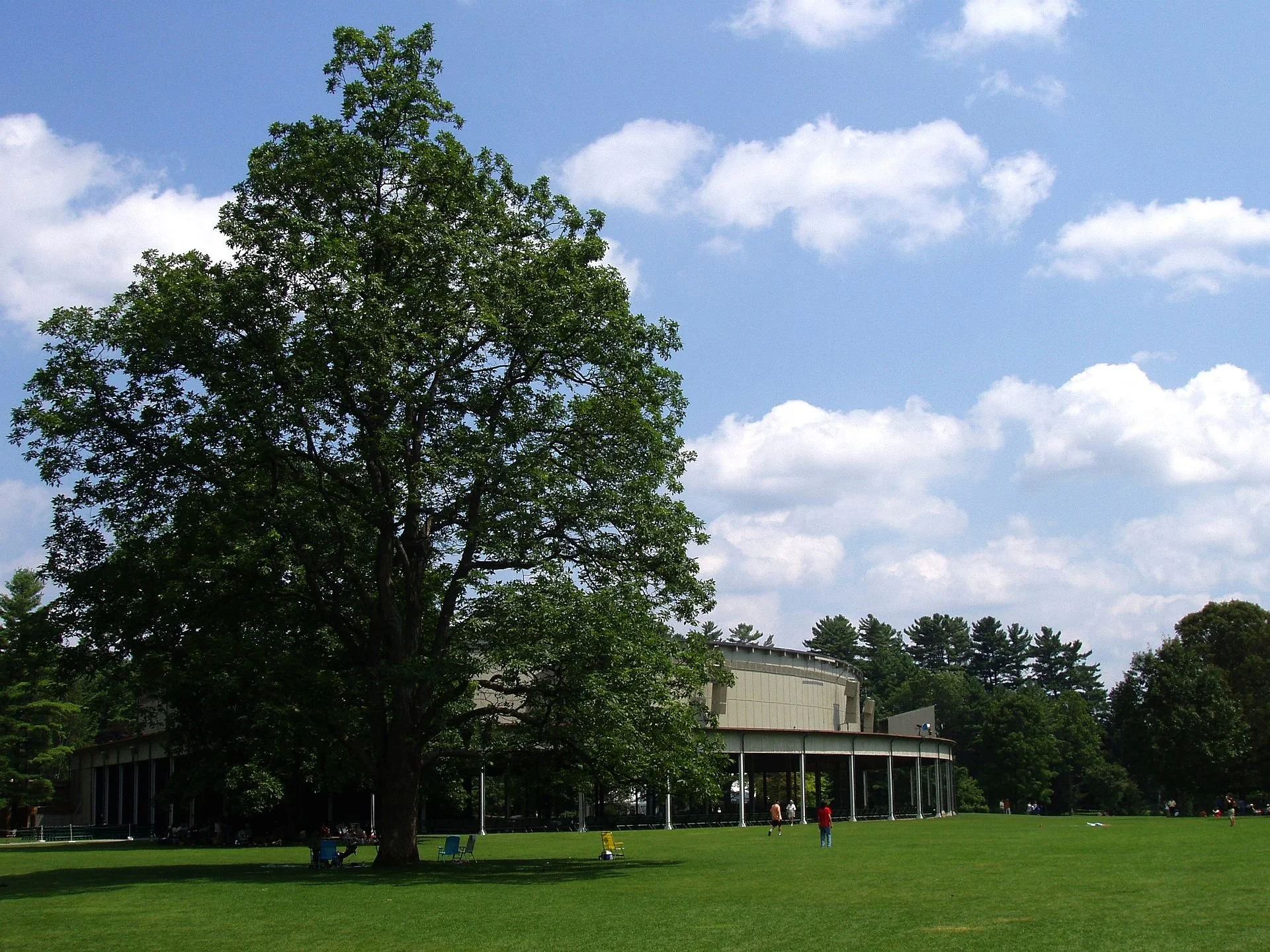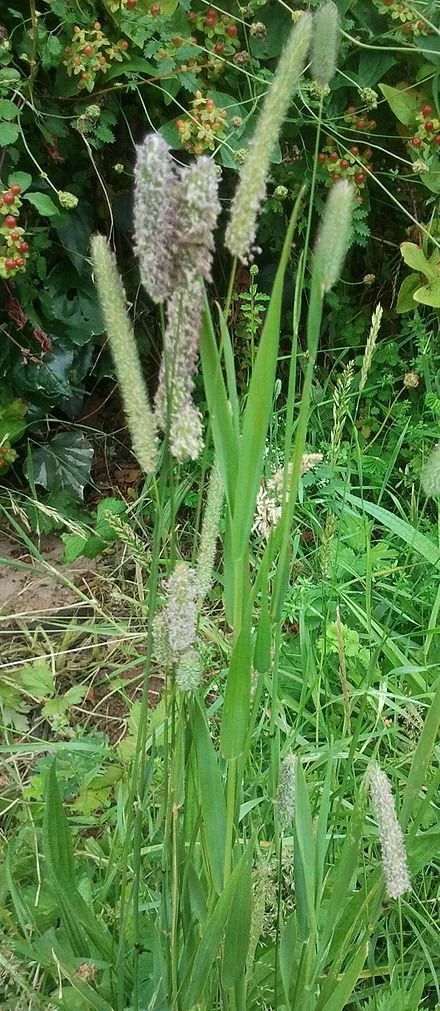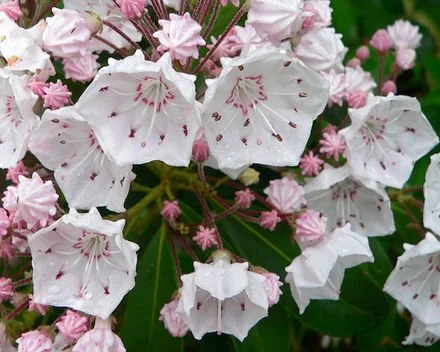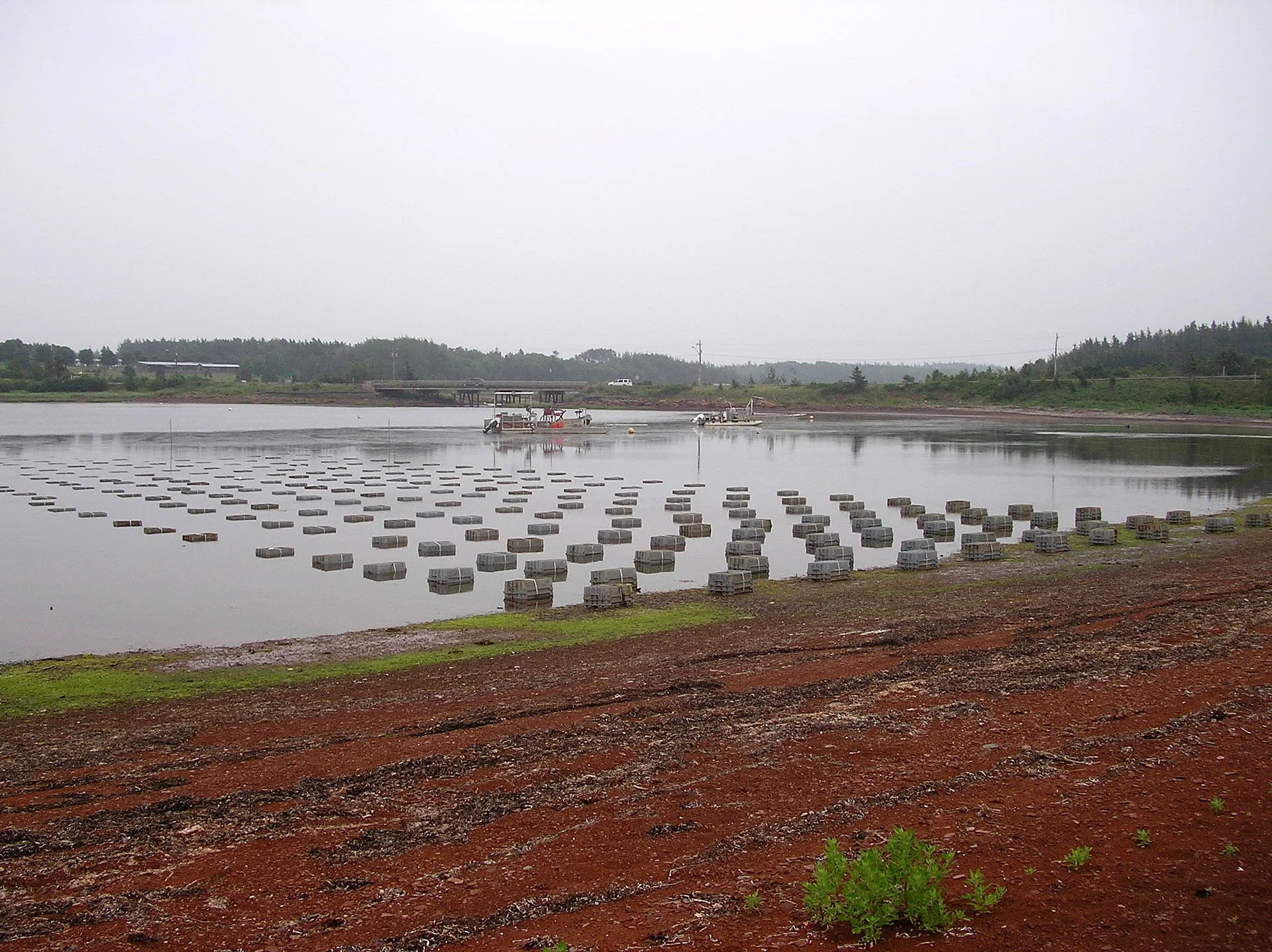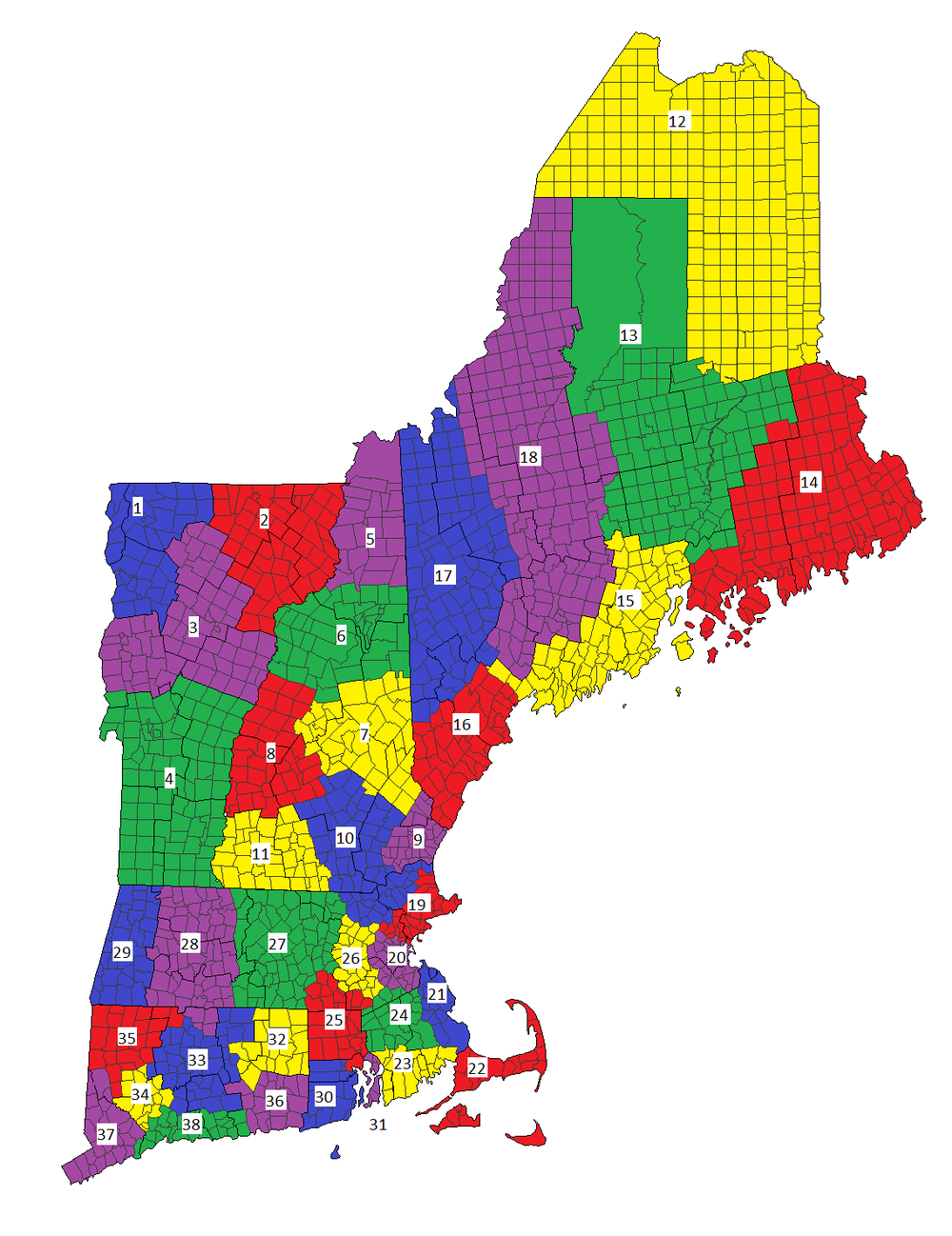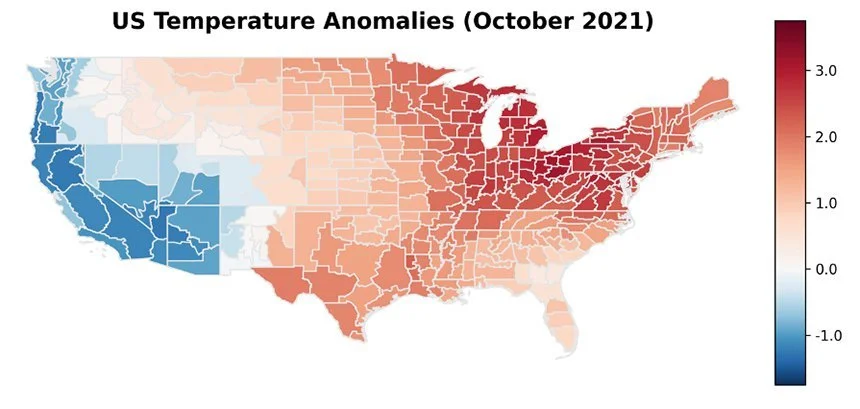Proposal to allow catching striped bass With Gill Nets riles anglers
A large striped bass.
Excerpted from an article in EcoRI News
“PROVIDENCE — Some Rhode Island anglers are opposing a proposed regulation from state environmental officials that would allow catching striped bass with gill nets.
“A handful of anglers from the Rhode Island Saltwater Anglers Association (RISAA) are against the suggested change to commercial striped bass fishing rules, which would allow commercial anglers to catch the Atlantic Ocean fish with a type of net that also catches them by accident.
“Anglers say the change would cause overfishing of the state’s striped bass population, which is in a regional rebuilding period after years of overfishing.
“Dave Monti, a charter boat captain and RISAA member, told ecoRI News that gill nets have a habit of catching fish species that they typically aren’t set up for.’’
William Morgan: All that and nothing at all; how not to promote a state
The State of Rhode Island, beset by the self-inflicted woes of failing infrastructure, persistent corruption and a lack of self-confidence, has launched a new tourism initiative that it hopes will bring swarms of visitors to our shores this summer. “All That” is the campaign’s motto.
All That, period. What’s more banal than a lighthouse?
—Commerce Rhode Island
Despite its 1990s hip-hop vibe, the pandering of Rhode Island to potential visitors is clothed in familiar banal corporate-speak, accompanied by photographs of lighthouses and Newport mansions, with “All That” splashed across them.
There are videos showing young and happy revelers biking, surfing, dining – creepily identical to the branding firm’s clips on Belize, Park City, and other fun destinations–what you might expect from a Florida agency whose motto is “We make momentum happen’’.
Why does our culturally and geographically endowed Rhode Island need this everywhere -- and — everyone sanitized vision of itself?
Rhode Island is not the only state going through the periodic contortions of trying to sell themselves to mythical, profligate-spending hordes of tourists. Politicians are also easy marks for snake-oil salesmen of new images that they hope will appeal to the electorate.
(“All That”has apparently cost taxpayers half a million dollars, but queries through the Access to Public Records Act will no doubt reveal a much higher figure.)
Political appointments offer clues about the cluelessness of heads of state, so it should come as no surprise that Anika Kirble-Huntley, the chief marketing officer for Rhode Island Commerce, has spent her entire career in the casino industry.
Fun-Sized, perhaps, but what potential tourist would be enchanted by this murky and grim image?
—VisitRhodeIsland.com
“All That” is the fourth tourism re-brand fiasco in recent years. There was the embarrassing “Fun-Sized” campaign, and the slightly mysterious “Whatever you do …” The most infamous, however, was when Rhode Island hired design-great Milton Glaser to come up with the tepid slogan “Cooler and Warmer,” complete with a clip of alleged local skateboarders zipping along the harborside – in Reykjavik. Slightly less egregious was “Discover Beautiful Rhode Island,” whose chief legacy is handsome signs positioned at the state line.
A quiet sign exhorting Rhode Islanders to discover where we live; tourists on I-195 are in a rush to get to Cape Cod.
— Photo by William Morgan
Rhode Island, to which my wife and I moved to by choice twenty-five years ago, may be the smallest state by area, yet it boasts 400 miles of Atlantic shore, a rich 400-year history seen in an incredible array of outstanding architecture. We were enchanted by Rhode Island’s diversity, its food, its educational institutions, and its palpable tradition of independence and tolerance.
Content with Rhode Island, I do not envy any state its bigger size. But, at the other side of the continent, I am in awe of Alaska’s waving identifier. It is an impeccable and unimpeachable symbol, perhaps the best advertisement for any American government entity. There are no mottos, no Latin phrases, no animals, or any potentially controversial figures – just a tribute to the northern sky.
The blue field with the gold stars of the Big Dipper pointing to the North Star, is a simple, strong, and recognizable design that has served boldly for a century, from territory to 49th state. This powerful, no-nonsense banner, adopted in 1927, will look fresh in another hundred years. Part of the brilliance of the design lies in its genesis: the American Legion sponsored a competition among school students throughout the territory that brought forth 700 entries. The winner was Benny Benson, a Native Alaskan orphan. For his brilliant scheme Benson was given a gold watch and $1,000. As “All That” demonstrates, the price of re-branding has gone way up, and handsome civic design is mostly a thing of the past.
The flag of Alaska, designed almost a century ago.
Rhode Island would have been better served by giving the money spent on the advertisements to folks to enable them to host visitors. The people who run the state gravitate to bigger scams, such as pro-sports stadiums, movie studios, and dubious highway contracts. Citizens will never see much of this squandered money again, even though we will be underwriting it for decades. Nevertheless, it is time to stop wasting dollars on silly, meaningless, and dubiously ineffective tourism promotions. Like the Alaska flag, Rhode Island itself ought to be advertisement enough.
William Morgan is an architectural writer based in Providence. His latest book is Academia: Collegiate Gothic Architecture in the United States (Abbeville).
Plastic pieces edge out cigarette butts as beach waste in Rhode Island
Pieces of plastic on beach.
Text from ecoRI News
“For the first time in the history of Rhode Island’s participation in the International Coastal Cleanup program, cigarette butts were not the item most collected by volunteer participants. Instead, small plastic and foam pieces — those pulverized bits that accumulate in wrack lines — took the lead, according to Save The Bay’s recently released 2023 International Coastal Cleanup Report.
“‘When this project started over 35 years ago, the focus was on recording the most common types of identifiable trash so that we could get a picture of what was littering our shores and where it was coming from,’ Save The Bay volunteer and internship manager July Lewis said. ‘In terms of the number of items picked up, cigarette butts were always at the top of the list.”’
“Last year, however, 2,830 local volunteers collected 23,468 plastic and foam pieces — and 21,165 cigarette butts.’’
To read the whole article, please hit this link.
— Save The Bay graphic
Projecting our drinking-water needs in a warmer and wetter climate
Adapted from Robert Whitcomb’s “Digital Diary,’’ in GoLocal24.com
Discussions come up from time to time about whether to create another Rhode Island state reservoir, in the Big River Management Area, to supplement the Scituate Reservoir. To be useful they must consider scientifically and actuarily based projections of the effects of global warming as well as of population growth.
Given that New England is expected to become wetter over the next few decades, will the Ocean State really need another big reservoir? Maybe. A Big River Reservoir would apparently be mostly for the fast-developing southern part of Rhode Island, and development pressures around here will probably increase as Americans move north from the Sun Belt, where climate change will be more onerous than in the Northeast. Further, the heavy draw on ground water in South Country threatens to increase salt-water intrusion into coastal towns’ wells.
In any event, making projections of global-warming effects is becoming a big industry, with many consulting firms making a good living on it, and new public programs, such as the American Climate Corps, are being created to deal with it. By the way, I noticed in The Boston Guardian the other day that that city will be updating its evacuation routes for storms and other emergencies.
The challenge has been heightened by the development of the city’s Seaport District, which is virtually at sea level, as is downtown Providence. Will the Seaport District become the Venice of the Northeast?
Hit these links:
https://turnto10.com/news/videos/federal-government-put-the-kibosh-on-big-river-reservoir
http://www.wrb.ri.gov/policy_guidelines_brmalanduse.html
https://read.thebostonguardian.com/the-boston-guardian#2023/10/06/?article=4159446
This from Reuters:
“Energy companies, hedge funds and commodity traders are stepping up their use of financial products that let them bet on the weather, as they seek to protect themselves against - or profit from - the increasingly extreme global climate.’’
See:
Always headwinds
Wind-energy lease areas off Massachusetts and Rhode Island as of October, 2022
The Massachusetts Wind Technology Testing Center, in Boston’s Charlestown section.
— Photo by vArnoldReinhold
Adapted from Robert Whitcomb’s “Digital Diary,’’ in GoLocal24.com
It was good to hear that the U.S. Interior Department has approved Revolution Wind’s big (700 megawatts) project, southwest of Martha’s Vineyard. The project could provide electricity for 350,000 homes and create about 1,200 construction jobs.
The department has also approved the Vineyard Wind 1 project, off Massachusetts, the South Fork Wind project, off Rhode Island and New York, and the Ocean Wind 1 project, off New Jersey.
But the regulatory approval process moves at glacial speed, and litigation always threatens to stop such projects in their tracks. Big factors are nimbyism by coastal residents (often led by affluent summer people) who say that they don’t want to look at wind turbines, as well as opposition by some in the fishing sector because of the mostly temporary disruptions in the areas where they’d be installed. Of course, the damage caused by man-made global warming happens everywhere, in varying degrees of severity.
And the supports for offshore turbines act as artificial reefs that draw fish. Wouldn’t fishermen like that?
Installing any energy source creates problems, but let’s make rational comparisons….
The complaints by offshore-wind foes are outstandingly hypocritical. Consider that the fossil-fuel burning that wind power is meant to partly replace poses an existential risk to fishing interests by dangerously warming and acidifying the water and disrupting major ocean currents such as the Gulf Stream. Fossil-fuel burning destroys food sources of marine animals, including whales.
Then there are those pesky oil spills and the disruptions to marine animals by speeding oil tankers.
When you look closely at opposition to coastal and offshore wind projects you see money from – you guessed it! – the oil and gas industry.
Take a look at the stuff in these links:
https://electrek.co/2022/04/18/the-first-us-offshore-wind-farm-has-had-no-negative-effect-on-fish-finds-groundbreaking-study/
https://grist.org/politics/republicans-fossil-fuels-the-gop-donors-behind-a-growing-misinformation-campaign-to-stop-offshore-wind/
A public path to the shore
Looking at Weekapaug, showing the breachway, jetty, channel, Fenway Beach and oceanfront homes.
Adapted from Robert Whitcomb’s “Digital Diary,’’ in GoLocal24.com
This will drive some affluent summer people bonkers but Rhode Island Atty. Gen. Peter Neronha rightfully expressed his “strong support” for making the “Spring Avenue Extension” and a sand path in Westerly’s exclusive Weekapaug section a state-recognized public right-of-way to the beach.
Well-heeled locals understandably have tried to block the public from this passage but there’s plenty of historical evidence that supports the public’s right to use this route. Legal decisions and disputes involving access to the ocean in New England go back to colonial days.
“It is time to ensure Spring Avenue is permanently and forever public and free of the private encroachments that have unlawfully hindered access to the shore in recent decades,” Mr. Neronha told the Rhode Island Coastal Resources Management Council.
Will this be a precedent for ending other Rhode Island shoreline-access disputes?
Bella DeVaan: Swift superfans may have struck blow against monopoly
Taylor Swift’s fans paid for the singer’s mansion — the white Colonial Revival structure at the top of the hill —- in the Watch Hill section of Westerly, R.I. The house, called High Watch, was formerly named Holiday House and also called the Harkness House (after a family enriched by Standard Oil who lived there for a time) by locals, is an 11,000-square-foot edifice on five acres that she bought for $17.75 million in 2013. The house was built in 1929-1930.
— Photo by JJBers - https://www.flickr.com/photos/jjbers/33980495256/
Via OtherWords.org
As the cost of food, travel, and gifts complicate holiday plans across the country, millions of Americans have been awakened to the sinister power of monopolies.
But now there are exciting new possibilities to rein them in.
This November, legions of new anti-monopolists were born. They’re Taylor Swift’s superfans — and they just might be the reason the government breaks up Ticketmaster.
Hoping to get pre-sale tickets to their favorite pop star’s upcoming tour, millions of “Swifties” waited in endless electronic queues, only to be hit with sky-high prices and exorbitant fees — if they were able to snag a ticket at all.
“Ticket prices may fluctuate, upon demand, at any time,” read an ominous warning on the Ticketmaster website.
And they did: Under Ticketmaster’s “dynamic pricing” system, fans reported ticket prices running up to thousands of dollars — not including hefty fees. Prices spiked even higher on the secondary resale market. On StubHub, ticket listings reached upwards of $95,000.
Finally, Ticketmaster threw in the towel and canceled subsequent presale windows. Their site crashed thousands of times. It was mayhem — and thanks to an unchecked monopoly, fans had no other option.
But the Swifties struck back. Hours after Taylor Swift released a statement apologizing to fans and chastising Ticketmaster, the Department of Justice (DOJ) announced an investigation of Live Nation Entertainment, which owns Ticketmaster.
While their investigation wasn’t prompted by Swift, reported the New York Times, Swifties’ wave of discontent was overwhelming enough to warrant the department’s public disclosure. Immediately after, the company that had been bragging about a record-smashing 2022 saw its stock plummet.
How did we get here? When it comes to antitrust issues, the U.S. government has essentially been asleep at the wheel, allowing Ticketmaster’s monopoly to crush its competition for over a decade.
In 2010, Ticketmaster and Live Nation merged into Live Nation Entertainment. The merger was subject to a relatively weak consent decree, which asked the merged companies not to abuse their live venue dominance. But it’s been easy for Live Nation Entertainment to intimidate their naysayers and flout guidelines.
“Ticketmaster bullies venues into not working with their competitors,” explains Chokepoint Capitalism author Cory Doctorow. “They bully smaller artists by denying them management. They bully big artists by controlling their ticket prices and letting their fans down. And they bully their customers into paying exorbitant prices for tickets.”
Well before the Swift fiasco, a coalition of research organizations and live event workers launched the Break Up Ticketmaster campaign asking the Department of Justice to “investigate and unwind” the live events monopoly. The campaign quickly gained ground, generating tens of thousands of signatures on an advocacy letter.
Policy makers are now echoing that call.
“Consumers deserve better than this anti-hero behavior,” tweeted Senator Richard Blumenthal (D-CT), punning off a song from Swift’s latest album, Midnights.
And on MSNBC, Senate Antitrust Committee chair Amy Klobuchar (D.-Minn.) promised a Senate hearing. She’s also co-authored bills with Senators Chuck Grassley (R-Iowa) and Mike Lee (R-Utah) to facilitate antitrust enforcement with new filing, funding, and state empowerment rules.
The attorney general of Tennessee — home to the “angriest Swifties” — opened an investigation into Ticketmaster’s misconduct, too.
President Biden recently directed his administration to “reduce or eliminate” junk fees like Ticketmasters’ infamous extra charges, which sometimes total up to 78 percent of the cost of a ticket. He’s also appointed a passel of antitrust enforcers and signed a robust, competition-oriented executive order in his first months in the Oval Office.
Monopolies aren’t just fleecing concert-goers. All of us experience the villainy of monopolies — in the high price of a tight seat on a plane, in the destruction of local journalism, in skyrocketing monthly rent and food prices, or in the marginalization of small online businesses.
So, present day monopolists, steel yourselves and remember: When you provoke a superfan, they’ll come for you.Bella DeVaan
Bella DeVaan is a program associate at the Institute for Policy Studies and a co-editor of Inequality.org.
Frank Carini: Turtles threatened by local poachers with global ties
A Spotted Turtle.
An Eastern Box Turtle.
From ecoRI News (ecori.org)
Rhode Island’s reptiles and amphibians face pressure from numerous threats, and for many species, removal of even a single adult from the wild can lead to local extinction, according to the state’s herpetologist.
Since the local and/or regional future for many of these species — eastern spadefoot toad, northern leopard frog, northern diamondback terrapin, to name just a few — is in doubt, removing them from nature to keep as a pet or to sell is against the law. It’s illegal to sell, purchase, or own/possess native species in any context, even if acquired through a pet store or online, according to Rhode Island law.
Turtles are especially vulnerable, according to Scott Buchanan, who became the state’s first full-time herpetologist in 2018, because some species must reproduce for their entire lives to ensure just one hatchling survives to adulthood. The Rhode Island Department of Environmental Management (DEM) staffer said it takes years, sometimes a decade or more, for turtles to reach reproductive age, if they make it at all.
Buchanan recently told ecoRI News that “broadly, across taxa” the illegal taking, or poaching, of wildlife is a “huge issue.”
“Globally, it’s considered one of the driving forces of population declines and even extinctions,” he said.
Wildlife trade experts and conservation biologists such as Buchanan point to poaching — driven by demand in Asia, Europe, and the Unified States — as a contributing factor in the global decline of some freshwater turtles and tortoises.
Tortoises and turtles grow slowly, mature late, and can, if given the chance, live for decades. This slow and steady lifestyle served them well for millions of years, but now, in the face of growing human pressures, it has become a liability.
Of the 360 known turtle and tortoise species, 52 percent are threatened, according to the International Union for Conservation of Nature Red List of Threatened Species.
A group of global turtle and tortoise experts published a 2020 paper that noted “more than half of the 360 living species [187] and 482 total taxa (species and subspecies combined) are threatened with extinction. This places chelonians [turtles, terrapins, and tortoises] among the groups with the highest extinction risk of any sizaeble vertebrate group.”
Turtle populations are “declining rapidly” because of habitat loss, consumption by humans for food and traditional medicines, and collection for the international pet trade, according to the paper’s authors. Many could go extinct this century.
Buchanan’s involvement in dealing with the impact of poachers is primarily around North American turtles. He noted turtle diversity is high globally and in the eastern United States — in the Southeast more than the Northeast, however.
But state and federal law enforcement officials and wildlife biologists consider the illegal collection of turtles to be a conservation crisis occurring at an international scale, according to Buchanan, who is the co-chair of the Collaborative to Combat the Illegal Trade in Turtles (CCITT), formed in 2018 within Partners in Amphibian and Reptile Conservation.
In the past four years, CCITT, an organization of mostly state, federal and tribal biologists, has documented some 30 major smuggling cases in 15 states. Some involved a few dozen turtles, and others several thousand.
In Rhode Island, Buchanan said there are four turtle species of concern: the eastern box turtle; the spotted turtle; the wood turtle; and the northern diamondback terrapin.
Eastern Box (species of greatest conservation need): This turtle spends most of its time on land rather than in the water. They favor open woodlands, but can be found in floodplains, near vernal pools, ponds, streams, marshy meadows, and pastures. They reach sexual maturity by about 10 years of age. Females nest in June and lay an average of five eggs in open areas with sandy or loamy soil. Eggs hatch in late summer.
Spotted (species of greatest conservation need): These turtles are sensitive to disturbance. They are usually found in shallow, well-vegetated wetland habitats, such as vernal pools, marshes, swamps, bogs, and fens. They reach sexual maturity at 7-10 years of age. Females lay an average of four eggs in moist Sphagnum moss, grass tussocks, hummocks, or loamy soil. Females probably do not lay eggs more than once a season, and females do not lay eggs every year.
Wood (species of greatest conservation need): For part of the year they live in streams, slow rivers, shoreline habitats, and vernal pools, but in the summer they roam widely across terrestrial landscapes. They reach sexual maturity around 10. During late spring, one clutch of 4-12 eggs is typically laid in nesting sites consisting of sandy soil or gravel. Eggs hatch in late summer and the young move to water.
Northern Diamondback (state endangered): Their population has suffered greatly due to poaching and habitat loss. They are found in estuaries, coves, barrier beaches, tidal flats, and coastal marshes. They spend the day feeding and basking in the sun and bury themselves in the mud at night. They reach sexual maturity at about six years old. Females lay a clutch consisting of 4-18 eggs. Some females will lay more than one clutch in a season and hatching usually occurs in late August. The young spend the earlier years of life under tidal wrack (seaweed) and are rarely observed.
All four are high-demand species in the pet trade, according to Buchanan.
“There’s a lot of illegal collection that takes place all throughout the eastern United States, including in New England and Rhode Island,” he said. “There’s a lot of recent cases that involve hundreds and thousands of turtles from those species illegally collected from individual populations, which is just totally unsustainable and has an immediate and lasting impact on those populations.”
Other turtle species that can be found in Rhode Island include eastern painted, common snapping turtle, and eastern musk.
“We have a lot of turtles for a small state,” Buchanan said. “They’re a conservation priority because of their life history. They’re just inherently vulnerable to population declines.”
Most turtles fall victim to predators before they mature. Rhode Island’s turtles are also threatened by habitat loss and fragmentation and by car strikes when crossing roads to breeding grounds.
Poaching is just another human-caused threat to their existence.
The 16 eastern musk turtle hatchlings confiscated by Rhode Island environmental police from a West Warwick resident in September. (DEM)
In late September environmental police officers from DEM’s Division of Law Enforcement found 16 Eastern Musk Turtle hatchlings, a species native to Rhode Island and the eastern United States, in the home of a West Warwick man suspected of illegally advertising them for sale on Craigslist and Facebook.
The case resulted from a week-long investigation, during which the suspect offered two hatchlings to undercover environmental police officers for purchase, according to DEM.
The suspect was charged with 16 counts of possession of a protected reptile or amphibian without a permit. The turtles were taken to the Roger Williams Park Zoo, which has a room and equipment dedicated to the care of turtles seized from the illegal turtle trade. The turtles will be released back into the wild after clearing health screenings and disease testing, according to DEM.
The 16 turtles are still at the zoo and “doing well,” according to Buchanan. He said only a minority of turtles rescued from poachers are returned to the wild, because of concerns about disease and, more importantly, not being able to determine the area from which they were taken.
The man has claimed the hatchlings were raised in captivity, but state officials believe the parents were likely taken from the wild and that the case also involves actions taken in another state. The case remains under investigation.
Last November, at New York City’s John F. Kennedy International Airport, about 100 eastern box turtles were found confined in socks inside an illegal shipment to Asia. A deadly ranavirus outbreak among the turtles confiscated by the U.S. Fish & Wildlife Service highlighted the risks and cruelty of the illegal wildlife trade, according to the New England Aquarium.
Smuggled turtles are often wrapped tightly in socks to keep them from moving. (USFWS)
Federal wildlife officials discovered the wildlife smugglers put multiple turtles, taken illegally from the wild, together into one box without food or water. Found hidden inside falsely labeled boxes, each turtle had been stuffed inside a tight sock to prevent it from moving.
The New England Aquarium took in many of the turtles and enlisted Zoo New England and Roger Williams Park Zoo to assist with treating the animals that were in poor health, suffering from dehydration and eye infections.
Buchanan said the global demand for box turtles has surged during the past few years.
A Chinese national was sentenced last year to 38 months in prison and fined $10,000 for money laundering after previously pleading guilty to financing a nationwide smuggling ring that sent 1,500 turtles worth nearly $2.3 million from the United States to China. The man used PayPal, credit cards, and bank transfers to buy the turtles from U.S. buyers advertising them on social media and reptile websites and sold them to Hong Kong reptile markets.
He trafficked in five turtle species, including the Eastern Box Turtle, protected by the Convention on International Trade in Endangered Species of Wild Fauna and Flora treaty.
Turtles, especially freshwater species, are among the world’s most trafficked animals, because, as Buchanan noted, reptiles can be kept in “explicitly inhumane conditions” — say, a sock inside a cardboard box — for a significant period of time.
“Enough of them survive to make it economical [for the criminal enterprise],” said Buchanan, noting most amphibians are too fragile to keep alive for that long.
Criminal networks connect with buyers who then sell the turtles as pets, to collectors, and to commercial breeders. Some species are coveted for their colorful shells or unusual appearance. In many countries, this illegal trade is either poorly regulated or unregulated.
To help protect Rhode Island’s native species, you can submit observations of amphibians and reptiles to DEM scientists online.
“Remember never to share turtle locations online,” according to DEM. “It can be exciting to see turtles in the wild, and to share your discovery. But before you take a photo of a turtle in the wild, turn off the geolocation on your phone. If you post a turtle photo on social media, don’t include information about where you found it. Poachers use location information to target sites.”
There are a few reptiles and amphibians that can hunted legally in Rhode Island: snapping turtles, bullfrogs, and green frogs. A current fishing, hunting, or trapping license is required and hunting/trapping must be conducted in compliance with season and size regulations. All animals harvested must be killed immediately following capture, as possession of live turtles or frogs is illegal.
Turtle traps must be marked with the trapper’s name and address, checked every 24 hours, and set in a manner that will allow turtles access to air, according to DEM. All bycatch must be released immediately at the location where the trap was set.
“This illegal collection of turtles … I think most people have a perception that it’s disparate or kind of small-time … it’s just some yahoos out there collecting a few turtles, when in fact it’s perfectly accurate to say the norm is international criminal syndicates that are driving the trade in turtles that leads to the illegal collection here in the U.S.,” Buchanan said. “There’s often times a local collector who’s in contact with a middleman who’s in contact with a criminal network that’s also involved in things like drug trafficking and human trafficking.”
Note: The sexual maturity and nesting habits of the four turtle species of concern in Rhode Island are based on their life and conditions here. For more information about the turtles of Rhode Island, click here. To watch a short U.S. Fish & Wildlife Service video about the importance of turtles and the threat from poaching, click here.
Frank Carini is co-founder and senior reporter for ecoRI News.
'Rhode Island doesn't compute'
Graphic by TUBS
“I know it sounds harsh, but Rhode Island is too small to be a state….
“If you have any doubts, you need only look at the map. New England, as you can see, is a top-heavy protrusion squared off at the bottom…. Maine of course takes up all the uneven, misshapen space at the top right, which is fine for Maine, because nobody pays attention to Maine anyway.
“New Hampshire and Vermont, by contrast, fit together in a perfectly tidy and orderly Yankee way, one bulging a bit in the north and the other doing the same in the south. They couldn’t be a better match. Beneath them, Massachusetts occupies a sensible, rectangular slab of territory with a somewhat untidy slop-over at Cape Cod. … Rhode Island, I’m afraid, is something else. Rhode Island does not compute.
“Look at the way it cringes there, occupying a sliver of land so inconsequential that the names of its cities and towns have to be entered vertically on the map. It is foolish for something so microscopic to go around posing as a state….’’
— Donald Dale Jackson (1935-2005), in “The Farewell State,’’ in a 2000 Smithsonian Magazine article
Llewellyn King: For fairness and privacy, bring back cash
Once at the St. Francis Hotel in San Francisco, I went to check in, and when I reached for my wallet it wasn’t there. The clerk said that I wouldn’t be able to check in without a credit card.
I explained that I had, mercifully, in another pocket, enough cash to pay for the stay. Reluctantly, they took more than enough of it for the two days and made a big point of telling me not to sign for even a cup of coffee.
Nowadays, I doubt they would accept my cash deposit.
Real people carry credit cards. Non-people — a subspecies of the American customer — are without. Woe to those.
Today there are more of these non-people because one of the lasting effects of the COVID pandemic is that cash is out, and plastic is all. No plastic, no go.
Hotels, airlines and even coffee shops have gone cashless. Ostensibly, this is because it is healthier. Truthfully, they don’t want to be bothered. Cash is a problem; credit is easier. In fact, from the vendor’s point of view, cash sucks, credit is cool.
At a large hotel in Orange County, Calif., where I have been attending a conference, I tried to buy a coffee at Starbucks. “I don’t take cash,” said the barista, primly. “Just credit cards and room service.”
This caused me to wonder again about the legions of Americans who don’t have credit cards, some of whom don’t want them, but most don’t have credit or have been turned down.
If we have a recession, which now seems inevitable, there will be more people without credit and immobilized by the post-COVID realities of the plastic-favored world.
Cash on hand won’t save them. They are the unbanked, a lesser order of our citizenry.
For starters, millions of the working poor are mostly without credit. It is hard to worry about the niceties of credit when you struggle to get food to the table for the family.
In this new world, the cardless also are immobilized.
Consider what being without plastic means: You can’t make a reservation on Amtrak or an airline. You must go to an airport, as airlines no longer have free-standing ticket offices. Then you will learn that you must use a reverse ATM to buy a card with cash to buy a ticket. Amtrak still takes cash, but you must go to a railroad station.
The first consequence is, in most cases, you will pay a lot more if you try to buy the ticket on the day of travel. Those tempting “book now and save” ads are only for credit card holders.
You can’t get to the railroad station or the airport on a ride-sharing service because they work only with credit cards.
So the luckless, who probably don’t have plastic because of financial problems, will pay more because they will be paying mostly at the last minute, and they will be charged to convert their cash to plastic at the airport. These travelers won’t be able to buy a drink or internet service because that requires you to file a credit card before you board.
It is an old story: the poor pay more. Now they may not be allowed to pay with the currency of the land.
An odd byproduct of the move to plastic is a further blow to privacy. Cellphones and security cameras have already stripped away much of our privacy. Will the fact that this very morning I bought a latte and a croissant with a credit card cause me to be inundated with Internet advertisements for designer coffee and pastry?
What would the deduction be by a suspicious partner if the credit card bill showed two lattes and two croissants?
Bring back cash. It was universal, left no record, and was preferred by merchants. Now they don’t want it, even for a coffee.
On Twitter: @llewellynking2
Llewellyn King is executive producer and host of White House Chronicle, on PBS. He’s based in Rhode Island and Washington, D.C.
White House Chronicle
Inside Sources
Colleen Cronin: The big potential of shellfish aquaculture
Live blue mussels on a rocky substrate
— Photo by Andreas Trepte
From ecoRI News (ecori.org)
The sound of thousands of mussels moving on conveyor belts and clanking through sorting machines almost drowned out Greg Silkes as he tried to explain how the shellfish get from the ocean, through the processing plant, to plates around North America.
Silkes is the general manager American Mussel Harvesters, one of the largest mussel producers in North America, and he helps run the business along with his father and other family members. On Wednesday, the Silkes and America’s Seafood Campaign hosted U.S. Sen. Jack Reed (D-R.I.), and other officials and seafood stakeholders at their location in North Kingstown, R.I., to discuss the shellfish-farming industry and its importance to public health, the economy, and reducing carbon emissions.
American Mussel Harvesters has been around since 1986 and has grown from a small operation with one boat and one phone to a large enterprise that ships mussels, clams, and oysters around the country.
Rather than fishing from pockets of naturally occurring shellfish on the seafloor, American Mussel Harvesters grow their product from tiny seeds in lots in the ocean. Greg Silkes said that a bag about the size of a shoe box can store millions of itty-bitty shellfish.
Overall, it takes about two to four years to get the shellfish from seed to table, but, depending on the maturity of the seeds American Mussel Harvesters buys, it usually takes six to eight months to grow and process their product and get it on the market.
As workers sorted the mussels into different grades, packed them into netted bags, and placed them in boxes filled with ice, Silkes said the shipment would be headed to a nearby Market Basket.
In the last two years the business model has shifted away from restaurants and toward retail because of the pandemic, Silkes said, and they’ve automated more of their processing plant to accommodate that change.
Still, American Mussel Harvesters does sell to local restaurants. “I love going to eat and saying this is my product,” Silkes said.
Later, on a boat specifically outfitted for shellfish harvesting, the group, which included several members of the Silkes family, Reed, and representatives from National Oceanic and Atmospheric Administration (NOAA), Rhode Island Department of Environmental Management (DEM), the Rhode Island Food Policy Council, and East Coast Shellfish Growers Association, sat down for a round table discussion about the industry.
Bill Silkes, the owner and founder of American Mussel Harvesters, started off the discussion thanking Reed for his work to promote shellfish farming in Rhode Island. “Under your watch,” Rhode Island’s gone from zero to more than 40 farms, Silkes told the senator.
Reed noted that it’s an important industry “not just to Rhode Island, but to the entire nation.”
According to the Commercial Fisheries Research Foundation, in R.I., the fisheries and seafood sector — which includes commercial fishing and shellfishing, fishing charters, processing, professional service firms, retail and wholesale seafood dealers — consists of 428 firms that generated 3,147 jobs and $538.33 million of gross sales in 2016. Including spillover effects across all sectors of the R.I. economy, the total economic impact was 4,381 jobs and an output of $419.83 million. The Port of Galilee alone hosts 240 fishermen that bring in 48 million pounds of seafood annually.
As the industry continues to grow, Bill Silkes said, a lack of dock space and growing space will impact local businesses. Indicating the vessel hosting the round-table talk, Silkes said it had already been kicked out of a slip once to accommodate a yacht.
He also noted efforts to start moving farming into federal waters, something that has made more progress in the last few months than in previous years.
“The opportunity is enormous,” he said.
Assistant administrator for NOAA National Marine Fisheries Service Janet Coit said she’s been working to get aquaculture out of state waters and that part of the challenge is that permitting will involve several different groups.
Coit, the former DEM director, said she sees the “same issues” federally in getting farms up and running as there were in Rhode Island, “just at a different scale.”
Bob Ballou, assistant to the director of DEM, talked about RI Seafood, the state-run marketing campaign designed to get more Rhode Islanders eating local catch.
Ballou said the campaign not only supports the seafood industry, it also provides economic, public health, food security, and environmental benefits in a “win-win-win-win-win” situation.
Seafood produces six times less than the carbon emissions of beef, said Diane Lynch, president of the Rhode Island Food Policy Council, so shifting protein consumption toward foods like shellfish and away from cattle could help to mitigate the effects of climate change.
“We’re just slowing [climate change] down, it’s too late to stop… but we have to do much, much more,” Reed said, adding that the seafood industry is “much kinder to the environment than some other folks.”
Linda Cornish, president of the Seafood Nutrition Partnership, added that on top of the other benefits, seafood is a valuable nutritional resource and may contribute positively to mental health.
At the end of the discussion, Mason Silkes brought out fresh oysters and showed Reed how to shuck them while the group slurped them down.
Colleen Cronin is a Report for America corps member who writes about environmental issues in rural Rhode Island for ecoRI News.
Cynthia Drummond: These clingers might send you to the ER
Clinging jellyfish
From ecoRI News (ecori.org)
CHARLESTOWN, R.I. — Recent warnings about the presence of clinging jellyfish in some coastal ponds have caused a stir, because the tiny organisms sting, and they are difficult to spot.
People who use the ponds should be aware of the possibility they might encounter clinging jellyfish, or gonionemus vertens.
Katie Rodrigue, principal marine biologist with the Rhode Island Department of Environmental Management’s Division of Marine Fisheries, has been monitoring clinging jellyfish, because while their sting is an unpleasant nuisance for most people, others may experience serious allergic reactions.
“The reason it’s a cause for concern is because, for some individuals, it can cause a severe sting,” she said. “In 2019, I believe it was, we had a couple of people end up in South County Hospital after being stung, because they had a pretty severe reaction to it.”
Clinging jellyfish have two life stages — a polyp and a medusa, which is produced by the polyp. The polyps, which are only about half a millimeter in size, are found in Rhode Island throughout the year and produce medusae in mid- to late summer. A single polyp will produce multiple medusae, and it is during this medusa stage that the organisms develop tentacles, and become jellyfish that sting.
“There’s two life stages of it, and the medusa stage is what we would recognize as the jellyfish — the bell with the tentacles,” Rodrigue said.
The clinging jellyfish is an invasive species that was first recorded on Cape Cod and in Groton, Conn., in the late 1800s. That population, which originated in the Eastern Pacific, declined as eelgrass beds died.
In the 1990s, clinging jellyfish began to make a comeback and are associated with a North Pacific species that produces more toxic stings.
How did this species get all the way to New England? Rodrigue said it could have made the trip as a polyp.
“Because that polyp stage can latch onto hard surfaces, it could have latched onto a ship’s hull,” she said. “I think one theory I read about was bringing oysters in. That could have brought in some of those polyps.”
What distinguishes clinging jellyfish is a reddish-brown “x” mark on the bell, but that marking doesn’t mean they are easy to detect.
“They’re really tough to see, especially during the day, and they get their name ‘clinging jellyfish’ because they like to hold on to eelgrass and other submerged vegetation,” Rodrigue said. “They sort of hide during the day and hang on, but if they get disturbed, say, if somebody’s walking through an eelgrass bed or something, they would release off of it and swim into the water column, and that’s when somebody would be able to encounter them.”
Clinging jellyfish have sticky tentacles, armed with cells with barbed structures called nematocysts, which contain venom.
“Those tentacles can kind of stick to your skin, and those nematocysts will fire,” Rodrigue said. “It’s almost like a tiny needle that penetrates the skin and it releases that venom into your skin, and that’s what causes the stinging sensation, and the tentacles have tons of nematocysts on them. Many jellyfish have this, and anemones, and other animals like that.”
Clinging jellyfish are active at night, hunting zooplankton.
“At night is when they’ll release themselves off of the eelgrass and then they’re in the water column, feeding on zooplankton,” Rodrigue said. “And so, they’ll be a little bit more mobile at night.”
So far this summer, clinging jellyfish have been recorded in Potter Pond in South Kingstown and parts of Ninigret Pond. In previous years, they have been documented in Point Judith Pond and the Narrow River. It’s important to keep in mind, however, that they could be living in other waterbodies and just haven’t been spotted yet.
Clinging jellyfish are not the only species that people should be watching for. Salt Ponds Coalition president Arthur Ganz, a retired marine biologist, said he had not been notified of any encounters with clinging jellyfish this summer and described the stinging sea nettle jellyfish as being far more numerous.
“Sea nettles are very abundant in the ponds, more so, I’m going to say, over the last 20 years,” Ganz said. “Their numbers have very much increased. We’d see them occasionally in the real hot summer, but now, they’re everywhere. I was out on my boat and I just looked down at my mooring and there was probably 20 within a square meter. So, they are the ones that are the biggest nuisance.”
More benign, non-stinging jellyfish species such as comb and moon jellies also inhabit the Ocean State’s coastal ponds.
“They don’t have obvious tentacles and they don’t bother people,” Ganz said. “It’s essentially the sea nettles that are the biggest problem.”
On the ocean side, beachgoers should steer clear of the cyanea, or lion’s mane jellyfish, which can grow to be very large and is armed with long, stinging tentacles.
“They’ll give you a nasty sting, and what happens with the cyanea is, on the ocean side, they’ll break up in the surf, so the tentacles are floating free, so even though you don’t have one right there in your vision, you could get nailed by the broken-up tentacles,” Rodrigue said.
She suggests people who plan to spend time in the calmer areas of the salt ponds, especially near eelgrass beds, wear protective clothing.
“If you’re going to be in one of these coastal-pond environments, an area that’s very calm and protected and has a lot of submerged vegetation, I suggest just covering up,” she said. “If there’s a barrier between the jellyfish and your skin, that’s going to be the best bet to avoid getting stung; waders, wet suit, even leggings will all help with that.”
People who are stung should apply plain, white vinegar to the affected area.
“What that’ll do is at least prevent any more stinging cells from firing,” Rodrigue said, adding that the old remedy of pouring urine on a sting is definitely not recommended.
“Do not do that,” she said. “If anything, that can actually make it worse. That, or using fresh water. A lot of people, because of the irritation, they might want to dump some cool, fresh water on it, but that’ll actually cause more stinging cells to fire on your skin.”
DEM asks people who encounter clinging jellyfish to contact the agency at 401-423-1923 or by email at DEM.MarineFisheries@dem.ri.gov. Reports can also be posted on Facebook or Instagram.
Cynthia Drummond is an ecoRI News contributor.
Species of the battle for liberty
“The Stamp Act was to go into operation on the first day of November. On the previous morning, the 'New Hampshire Gazette' appeared with a deep black border and all the typographical emblems of affliction, for was not Liberty dead?’’
— Thomas Bailey Aldrich (1836-1907), American writer, including as poet and critic, and editor. The Portsmouth, N.H., native is notable, among other achievements, for his editorship of the Boston-based The Atlantic Monthly magazine.
Thomas Bailey Aldrich House, part of Strawberry Banke Museum, Portsmouth, N.H.
Sullivan Ballou
“I have no misgivings about, or lack of confidence in the cause in which I am engaged, and my courage does not halt or falter. I know how strongly American Civilization now leans on the triumph of the Government and how great a debt we owe to those who went before us through the blood and sufferings of the Revolution. And I am willing—perfectly willing—to lay down all my joys in this life, to help maintain this Government, and to pay that debt.’’
—Sullivan Ballou (1829-1861), Rhode Island lawyer, politician and major in the Union Army in a letter to his wife, Sarah, shortly before he died of wounds suffered in the First Battle of Bull Run.
Cynthia Drummond:New England lawns are changing with the times
Tanglewood Music Shed and lawn, in Lenox, Mass. Music lovers sit and recline on this famous lawn while listening to summer concerts of the Boston Symphony Orchestra
— Photo by Daderot
From ecoRI News (ecori.org)
RICHMOND, R.I. — Love them or hate them, lawns aren’t going to disappear from the New England landscape anytime soon. Caring for those islands of green can be as casual as an occasional mowing, or as involved as season-long programs that include watering, adding nutrients and eliminating weeds and insect pests.
University of Rhode Island Professor Bridget Ruemmele teaches several turf grass courses, including management and irrigation technology. Her research focus is turf grass improvement.
In drought-prone states such as Texas, where Ruemmele worked before coming to Rhode Island, many municipalities require homeowners to use xeriscaping, landscapes composed of plants that need much less water than traditional lawns.
Ruemmele said lawns remain popular in Rhode Island because they provide areas for recreation, and they are less likely to harbor ticks.
“One of the advantages, of course, of having at least some lawn near your buildings is, you don’t have to worry as much about deer ticks [which spread Lyme disease]. That’s the big issue,” she said.
Recent hot, dry summers have resulted in watering restrictions in many towns, leaving lawns brown and stressed and prompting calls to URI from homeowners asking what they can do to counteract the effects of drought.
“We tend to have fairly regular rainfalls, but when there are droughts, the years we have droughts are when people all of a sudden go ‘Oh, maybe I should be concerned about it,’ and that’s when we get more calls and requests for information,” Ruemmele said.
Some homeowners are taking a more radical approach and reducing the sizes of their lawns. Young people may not be as interested in lawn maintenance and older couples who no longer have children at home don’t need the recreation space.
“As people seem to be aging, they’re more interested in not having as big of a lawn area,” Ruemmele said. “Some of these people who are reducing their lawn are spending hours and hours every week maintaining the alternative plants they put in, so it very much depends upon what kind of plants you decide to put in whether or not you’re going to be saving time, because if you’ve got a lawn, essentially, mow it once a week.”
The most widely used turf grass species, Kentucky blue grass, is not considered to be drought-tolerant, although Ruemmele said the original blue grasses were much tougher than the varieties sold today.
“For years, people associated it with high maintenance and that’s because, back when we were less concerned about the environment, breeders developed grasses that responded to increased irrigation and increased fertility, whereas the more common types of Kentucky blue grasses…they are the ones that were adapted to whatever the environment threw at them, so they were able to tolerate periods of stress and that’s a major emphasis that turf breeders have gone back to.”
With nutrient runoff, much of it from fertilizers, polluting coastal waters, Ruemmele said municipalities are beginning to restrict outdoor water use as well as the types of fertilizers that homeowners can apply to their lawns.
“The emphasis is on, especially, not automatically applying a fertilizer, emphasizing that you’re going to be getting a test of your [turf] fertility every couple of years and then only applying the fertilizer that’s recommended,” she said.
As an example, Ruemmele cited the intensively marketed “four step” program, in which most of the steps are usually unnecessary.
“What I think about the four-step program, is that if you don’t have grubs, you don’t need that stuff, and if you keep a nice, healthy, dense turf, that’s going to be eliminating most of any perceived weed problems that you might have, and you can eliminate that step. And so basically, the step that has fertilizer only is about the only one you really need,” she said.
Dana Millar, of West Kingston, is known for his organic lawn care service, although his company, Dana Designs, also provides conventional services to homeowners who request them. Most of Millar’s clients still ask for conventional services, but an increasing number of customers, about 65 at last count, prefer organic methods.
Organic lawn care is based on the premise that healthy turf grass requires healthy soil, so rather than applying chemicals to the grass, Millar uses a bottom-up approach, building nutrients in the soil that support the grass.
“Top down, you’re applying materials and products over the top,” he said. “Organically, you are encouraging the health of the soil, so the soil feeds the plant.”
Millar believes that organically grown grass is not only stronger, but also more resistant to environmental stressors.
“Over the period of the last two years, we’ve had greater drought than anybody had in memory and in this past year, there was more rain than anybody had in memory,” he said. “Each one of those climate-driven events stressed lawns in different ways. My organic lawns were more resilient, so in the drought, they went into drought stress later and came out of drought stress more quickly, and lots of times, didn’t need much repair, whereas lawns that may have been conventional had a harder time and they weren’t able to fend off insects. They weren’t able to fend off diseases and their recovery, in some cases, wasn’t complete. The turf was damaged and had to be completely restored.”
One of Millar’s early mentors was Earth Care Farm founder Mike Merner, a believer in the benefits of compost and the importance of nurturing the microorganisms that live in soil and make it productive.
Millar always begins an organic program with testing and amending the soil, which can be a complicated process.
“We need to know what the state of the soil is, so every organic program begins with a soil test, and we ask more from a soil test than the conventional test, because we want to know organic matter, we want to know cation exchange capacity, we want to know not only the soil pH, but its resistance to change. …This determines the type and amount of amendments that we might need to improve soil and gives us a baseline for expectations and a budget over a period of time,” he said.
While lawn care products have traditionally been marketed to men, Millar said many of the clients of his organic service are women who have taken over the responsibility of lawn maintenance from their male partners.
“I have lots of women clients who are at a point in their lives where they have the discretionary income and the authority in their households to make decisions which are usually the males,’ ” he said. “‘How are we going to treat our lawn? Why are we going to do this? I want a garden, I want to feel safe and I want my grandchildren to have the freedom to enjoy our lawn.’”
Cynthia Drummond is an ecoRI News contributor.
Timothy grass, probably named after Timothy Hanson, an American farmer and agriculturalist said to have introduced it from New England to the South in the early 18th Century. European settlers introduced it into New England in the late 1600s and by 1711 it had become known as Herd’s grass, after John Herd, a Maine farmer who began to cultivate it.
Cynthia Drummond: Nurture New England’s native plants
Blossoms of mountain laurel, a common shrub in southern New England
From ecoRI News (ecori.org)
A story in a recent issue of a national gardening magazine extolled the benefits of “naturalistic garden design,” a less constrained landscape that features native plants grouped in ecologically compatible communities.
The reader was encouraged to look for inspiration in the local ecosystem and to “suspend fussiness” to develop a wilder, more resilient garden that is in tune with the surrounding natural landscape.
Magazine articles about native plants indicate their growing acceptance as garden plants, but because they have co-evolved over thousands of years with native insect and bird species, these plants play a much more critical role.
David Gregg, director of the Rhode Island Natural History Survey, described native plants as central components in the evolution of the Rhode Island ecosystem.“They’re the environment and context in which all the other animals in our plants in our area evolved,” he said.
“So, the bees’ tongues are the right length to get the nectar from the flowers. The birds can eat the caterpillars that that eat those plants. The soil microbes are such that those plants can get nutrients from the soil instead of fertilizer.”
While gardeners have differing opinions on how “native” a plant should be, whether a garden should contain only native species, and whether those species should be native to Rhode Island, New England or beyond, more people are choosing to plant natives, even if it’s just a few to start. This higher level of awareness is evident in the recent growth of the membership of the nonprofit Rhode Island Wild Plant Society, which, in the past two years, has gone from about 400 members to more than 600.
Society vice president Sally Johnson said she is not sure why the organization has so many new members, but she said it is probably due to people spending more time at home as well as growing concerns about the climate crisis.
“A lot of us are out in our yards, outside more, and a lot of us are going for more walks because it’s COVID-safe, so we’re appreciating nature more, and that’s got to contribute to it,” she said. “The other factor, and this is my gut feeling on it, it’s got to be global warming. We see so much environmental destruction. There’s so much talk of resiliency. That contributes.”
Johnson also noted people were becoming more aware of the need to support pollinating insects and birds.
“People are going from the purely ornamental, showy plants, and understanding more the role of supporting pollinators and host plants,” she said. “The understanding of, it’s not just the pretty bees and butterflies, but it’s also the wasps and who’s going to live there over the winter and leaving your perennials up over the winter so that insects can overwinter in them.”
Michael Adamovic, author, photographer and and a botanist at Catskill Native Nursery, attributes the greater interest in native plants to the noticeable decline in insect populations.
“Natives are definitely increasing in popularity,” he said. “Probably one of the main reasons is that because in the last 20, 30 years, there’s been a large decline in insect populations. You would take a road trip, 20 or 30 years ago, and your car would be completely covered with insects. These days, you’re lucky if you get one or two splattered on it. The same thing goes for songbirds. The songbird population is really starting to decline, and people are finally starting to realize there’s something wrong with the environment.”
Adamovic said sales at the nursery took off during the pandemic and continue to be strong.
“Our sales probably at least doubled from the previous year,” he said. “We couldn’t keep up with the demand. And even last year, 2021, it was still going in the same direction and there’s no indication of it slowing down.”
Johnson, who owns a garden design business that uses native plants, said they can still be hard to source in Rhode Island, and she often has difficulty finding them for her clients.
“You can’t find native species,” she said. “… I had a client who had to put in native plants for a CRMC [Rhode Island Coastal Resources Management Council] permit by the end of October and she could only put in three species.”
The Rhody Native program, a federally funded initiative of the Rhode Island Natural History Survey, began in 2010, but ended in 2018. The initial objectives were to provide enhanced job training for unemployed nursery workers following the recession, and plant native species to fill the spaces where invasive plants had been removed.
“The idea was, all right, here’s another economic opportunity,” Gregg said. “Let’s gather seed and cut clippings from local sources and we’ll pay out-of-work nurserymen to grow them up for us. And then, we will use them in restoration projects and we’ll let nurseries and garden centers sell them to try to change people’s minds about natives.”
But when the federal funding ended, the idea of building a local native plant supply chain ran up against the realities of the nursery business.
“You can’t pay a professional staff on the kind of volume we were doing in Rhody Native plants, and there’s a couple of reasons,” Gregg said. “One is, the margins on propagating nursery stock are so thin, you have to do zillions of plants in order to make a business out of it. For native plants, you still have to order from far away because it won’t pay. We didn’t have the right model for making local plants pay.”
There was also an issue, Gregg added, with a tax-exempt nonprofit operating on tax-exempt land competing with commercial growers in Rhode Island.
Current garden trends favor native plants, a change Adamovic has also observed.
“They are going more toward native plants than they are non-native,” he said. “We still get a few people who don’t get it at all. They’ll come in and have this huge list of non-natives. They don’t really understand what the whole native thing is about, but every year that goes by, that’s decreasing.”
Johnson believes gardeners evolve at their own pace, and some people will adopt native plans more readily than others.
“I think you have to accept people for where they are and try to just gently move them,” she said. “We as a wild plant society are trying to move towards being purists, of only selling plants from Rhode Island and trying to get out seeds from Rhode Island, and I totally support that effort. … It’s important to realize that hey, if you don’t want to do your entire garden as native plants, at least start putting some in and start looking at them and thinking about them, and then you realize ‘Hey, the native goldenrod is kind of nice.’”
It is becoming increasingly important, Adamovic said, that people include native plants in their gardens.
“It’s really rewarding, too,” he said. “You put a native plant in your garden and you’re able to see that the caterpillar that ate it turned into a butterfly. You’re also providing a bunch of food for wildlife in general, and you’re really helping to save the environment by switching over to using natives.”
For Gregg, native plants are the foundation of Rhode Islanders’ sense of place.
“Rhode Islanders live in a place that has oak trees that drop their leaves in the winter and it’s got stone walls with moss and asters growing along them and it’s got native beach grasses,” he said. “You go to the beach, you see the little waving grasses. … If you want a place with palm trees and eight foot-high elephant grass, go somewhere else. Rhode Island is about a sense of place. It’s about our native plants.”
Native plant resources
Rhode Island Wild Plant Society native plant sales.
Xerces Society pollinator-friendly native plant lists.
Cynthia Drummond is an ecoRI News contributor.
Llewellyn King: The beauty of a woman’s slap
I have never met Will Smith, but I would like to just so that I could pump that hand — the hand that connected with Chris Rock’s cheek at the Oscars; the slap that was seen around the world.
That hand connecting with that unsuspecting cheek should start us on a happy back-to-the-future journey.
I would rather the striker had been a woman. Slapping men’s faces has a long and honorable tradition in female defense of rectitude.
We need to reinstall the periodic slapping of the male face as a part of the interaction between men and women so there are fewer instances of #MeToo. Once there has been a slap, there can be no later debate about who allowed what. An open-handed blow to the over-eager male face is declarative: Cut it out now. It is the unique female form of defense without having to take up judo, kickboxing or succumbing to unwanted advances. Slapping the pushy male face is, or was, instinctive.
A crisp slap of the face puts a definite and embarrassed end to “inappropriate touching.” A face slap is so articulate, so incontrovertible, so absolute and so very effective. It doesn’t ever get confused with “consensual,” “maybe” or “perhaps.”
Had a few more faces been slapped, there would be fewer TV personalities sitting out their lives in early retirement because they said they thought there was mutual consent. Had the face of one governor been slapped, he would have restrained his unlicensed hands from roving where they shouldn’t have, and he would still have a job. No equivocation or doubt; no he-said, she-said. A slap is a notable event, never forgotten by the deliverer or the receiver.
Neither the slapper nor the slapped quickly forgets the inside of the female hand swiftly connecting with the outside of the male face. It hurts the male ego far more than it stings the offending cheek or the delivering palm.
Question: Did she slap your face? How can a man answer that without a simple “yes” or “no”? A slap can’t later be confused with foreplay. You weren’t desired is an unambiguous statement implicit in the face slap. Once thus discouraged, further advance is not allowable, or is the beginning of #MeToo territory.
What happened to face slapping? Why did it go the way of couches in women’s restrooms and nose-powdering, as in “I have to powder my nose.” Such a delightful euphemism. Somewhere in the women’s movement some useful things got lost.
The last time, as I remember, when a face slap echoed around the world was when Vivien Leigh, playing Scarlett O’Hara in the movie Gone With the Wind, brought an open palm against the astounded cheek of Clark Gable, playing Rhett Butler.
When a woman delivers the unambiguous slap to the face of an over-eager man, she has an opportunity to accompany it with a solid verbal rebuke; to append a testy codicil. How about one of these: “What kind of women do you usually go out with?” “How dare you, lover boy?” “I told you, keep your hands to yourself.” Or a withering, “What do you think you’re doing?” That should deflate the aspiring Don Juan and send the putative lover back to computer dating.
You are probably wondering how often this writer’s face has been slapped? Only once, in quite a different circumstance and for quite a different offense. It was a shock, an ego-crusher, and I have an indelible memory of it.
Despite the current imbroglio between Will Smith and Chris Rock, the face slap remains uniquely a woman’s prerogative and a man’s shame. Whack!
On Twitter: @llewellynking2
Llewellyn King is executive producer and host of White House Chronicle, on PBS, and he’s based in Rhode Island and Washington, D.C.
Higher and higher
Adapted from Robert Whitcomb’s “Digital Diary,’’ in GoLocal24.com
Shoreline access continues to be a stormy issue in Rhode Island and some other coastal states. There’s constant conflict that pits beach walkers, swimmers and sitters from the general public against generally affluent shoreline house owners, who have taken over more and more of the New England coast, with many striving mightily to keep the public as far away from their houses as they can. Understandable!
There’s a measure in the Rhode Island House that attempts to end the old confusions about how high on a beach the public can go without being legally kicked off by irritated owners. (“We paid a lot of money for this place!”) It states that folks can go 10 feet landward beyond a “recognizable high tide line.’’ That’s defined as the mark left “upon tide flats, beaches, or along shore objects that indicates the intersection of the land with the water’s surface level at the maximum height reached by a rising tide.’’ (Lawyerly poetry!) That would often, but presumably not always, mean a line of seaweed, oil, shells or other debris.
None of this means that you could legally climb up the wall in front of someone’s house, whatever passes for the high-water mark.
A not very helpful 1982 state Supreme Court ruling said that the mean high-water mark is the appropriate boundary between the shoreline to which the public has access and private property, but the court said that determining the line requires “special surveying equipment and expertise.’’ What with the changes wrought by waves and storms, it can be mighty hard to find the high-tide mark in any case. Confused and/or nervous beach visitors would thus tend to move down to the low-tide mark (also not always easy to define). The new legislation doesn’t seem on the face of it to make things much easier for beach walkers to follow. And where can beach strollers sit down without being yelled at?
Inevitably, a shadowy group, with the windy title of “Shoreline Taxpayers for Respectful Traverse, Environmental Responsibility and Safety,’’ representing affluent owners, plans to fight the measure with lawsuits. Since the rich generally run America, I’d bet they’ll win; and I suspect that most of the group’s clients are from out of state.
(Some members of this same crowd also try to stop the sand from washing away in front of their houses by putting up hard barriers to catch and hold it. But that just ends up depriving the shores further down the shore of sand. Indeed, it worsens erosion.)
But wait! Rising seas caused by manmade global warming may make this issue more wrought. Estimates are that sea level will rise by almost a foot between now and 2050, and there will be more and worse hurricanes and other storms. That would push the high-tide mark (or marks), and the strolling public, further landward, toward those beach houses.
For that matter, it will also force some landowners to eventually abandon their houses, many of which shouldn’t have been put there in the first place, let alone subsidized by taxpayers through federal flood insurance and frequent repairs to beach roads by states and municipalities. Indeed, permanently removing structures from stretches of the immediate shore will be a rapidly increasing phenomenon in the next few decades. Sad. Most people love being close to the water, as real-estate prices suggest.
Will the Feds be buying out a lot of these properties through the Federal Emergency Management Agency?
Before the rise of the shoreline summer house, spawned by the money from the Industrial Revolution, few people in New England coastal communities built houses right along the shore. It was considered too insecure in the face of storms and flooding. Houses were built much higher up. So you can see that the oldest buildings in New England coastal towns are in village centers or associated with now mostly gone farms.
Part of my family has long lived in Falmouth, on Cape Cod. Some of their 18th and 19th Century houses are still standing near the town green. These people were in farming, boat building, fishing and assorted other trades. On the other hand, most of the houses around the harbors and along the beaches of the town date from the 1870’s and later, when they were built as summer places after the extension of the railroad brought affluent people, including some of my other ancestors, from the Boston area to summer on the Cape. This sort of movement was replicated on coasts, including the Great Lakes, around America.
Occasionally hurricanes or other big storms would damage or destroy the houses, but the owners would usually have enough money and/or insurance (including in the past few decades federal flood insurance) to rebuild in exactly the same insecure places.
In any event, with rapidly rising seas, that can’t go on. Let the great trek inland begin (if only a few dozen yards).
Out-of-staters vs. R.I. aquaculture
Oysters farmed in baskets on Prince Edward Island.
— Photo by Santryl
Adapted from Robert Whitcomb’s “Digital Diary,’’ in GoLocal24.com
New Rhode Island state rules mandate that people who want to expand or start new aquaculture farms (mostly shellfish) must identify property owners within 1,000 feet of their projects’ boundaries. The Coastal Resources Management Council will then notify those abutters about the proposal so that they have plenty of time to fight it.
Many, and in some places most, of the abutters will be wealthy out-of-state summer people who like to eat oysters, and can afford to buy lots of them, but many don’t want aquaculture near them, though it’s good for the area’s economy. They’ll get high-fee lawyers to try to block the farms.
John O. Harney: The state of the New England states as COVID winds down (for now?)
Regions of New England:
1. Northwest Vermont/Champlain Valley
2. Northeast Kingdom
3. Central Vermont
4. Southern Vermont
5. Great North Woods Region
6. White Mountains
7. Lakes Region
8. Dartmouth/Lake Sunapee Region
9. Seacoast Region
10. Merrimack Valley
11. Monadnock Region
12. Aroostook
13. Maine Highlands
14. Acadia/Down East
15. Mid-Coast/Penobscot Bay
16. Southern Maine/South Coast
17. Mountain and Lakes Region
18. Kennebec Valley
19. North Shore
20. Metro Boston
21. South Shore
22. Cape Cod and Islands
23. South Coast
24. Southeastern Massachusetts
25. Blackstone River Valley
26. Metrowest/Greater Boston
27. Central Massachusetts
28. Pioneer Valley
29. The Berkshires
30. South County
31. East Bay
32. Quiet Corner
33. Greater Hartford
34. Central Naugatuck Valley
35. Northwest Hills
36. Southeastern Connecticut/Greater New London
37. Western Connecticut
38. Connecticut Shoreline
From The New England Journal of Higher Education (NEJHE), a service of The New England Board of Higher Education (nebhe.org)
BOSTON
“This Covid-19 pandemic has been part of our lives for nearly two years now. It’s what we talk about at our kitchen tables over breakfast in the morning, and again over dinner at night. It gets brought up in nearly every conversation we have throughout the day, and it’s a topic at nearly every special gathering we attend,” Rhode Island Gov. Daniel McKee noted in his recent 2022 State of the State address.
Indeed, that was a consistent theme among all six New England governors’ 2022 State of the State speeches. As were plugs for innovation in healthcare, especially mental health, housing, workforce development, climate strategies, children’s services, transportation, schools, budgets and, with varying degrees of gratitude, acknowledgement of federal infusions of relief money.
Here are links to the full New England State of the State addresses, highlighting some key points from the beat:
Connecticut Gov. Ned Lamont’s 2022 State of the State Address
“Our budget invests 10 times more money than ever before in workforce development—with a hyper focus on trade schools, apprentice programs and tuition-free certificate programs where students of all ages can earn an industry-recognized credential in half the time, with a full-time job all but guaranteed.
This investment will train over 10,000 students and job seekers this year in courses designed by businesses around the skills that they need.
This isn’t just about providing people with credentials; this is about changing people’s lives.
A stay-at-home mom whose husband lost his job earned her pharmacy tech certificate in three months and now works at Yale New Haven Hospital.
A man who was homeless was provided housing, transportation, a laptop and training. He’s now a user support specialist for a large tech company.
These are just two examples of opportunities that completely change the course of someone’s life.
We are working with our partners in the trade unions to develop programs for the next generation of laser welders and pipefitters. Building on the amazing partnership between Hartford Hospital and Quinnipiac University, we are also ramping up our next generation of healthcare workers.
I want students and trainees to take a job in Connecticut, and I want Connecticut employers to hire from Connecticut first! To encourage that, we’re expanding a tax credit for small businesses that help repay their employees’ student loans. More reasons for your business to hire in Connecticut, and for graduates to stay in Connecticut—that’s the Connecticut difference.”
Maine Gov. Janet Mills’s 2022 State of the State Address
“It is also our responsibility to ensure that higher education is affordable.
And I’ve got some ideas to tackle that.
First, I am proposing funding in my supplemental budget to stave off tuition hikes across the University of Maine System, to keep university education in Maine affordable.
Secondly, thinking especially about all those young people whose aspirations have been most impacted by the pandemic, I propose making two years of community college free.
To the high school classes of 2020 through 2023—if you enroll full-time in a Maine community college this fall or next, the State of Maine will cover every last dollar of your tuition so you can obtain a one-year certificate or two-year associate degree and graduate unburdened by debt and ready to enter the workforce.
And if you are someone who’s already started a two-year program, we’ve got your back too. We will cover the last dollar of your second year.”
Massachusetts Gov. Charlie Baker’s 2022 State of the State Address
“We increased public school spending by $1.6 billion, and fully funded the game-changing Student Opportunity Act.
We invested over $100 million in modernizing equipment at our vocational and technical programs, bringing opportunities to thousands of students and young adults.
We dramatically expanded STEM programming, and we helped thousands of high school students from Gateway Cities earn college credits free through our Early College programs.”
New Hampshire Gov. Chris Sununu’s State of the State Address
“Our way of life here in the 603 is the best of the best.
We didn’t get here by accident—we did it through smart management, prioritizing individuals over government, citizens over systems, and delivering results with the immense responsibility of properly managing our citizens tax dollars.
As other states were forced to buckle down and weather the storm, we took a more proactive approach in 2021. In just the last year, we:
• Cut the statewide property tax by $100 million to provide relief to New Hampshire taxpayers
• Cut the rooms and meals tax
• Cut business taxes—again
• Began permanently phasing out the interest and dividends tax
And while we heard scary stories of how cutting taxes and returning such large amounts of money to citizens and towns would ‘cost too much’, the actual results have played out exactly as we planned, record tax revenue pouring into New Hampshire, exceeding all surplus estimates, allowing us to double the State’s Rainy Day Fund to over $250 million.”
Rhode Island Gov. Daniel McKee’s State of the State Address
“We all know that the economy was changing well before the pandemic. A college degree or credential is a basic qualification for over 70 percent of jobs created since 2008. Although we have made great progress over the last decade, there’s more to do.
Let’s launch Rhode Island’s first Higher Ed Academy, a statewide effort to meet Rhode Islanders where they are and provide access to education and training, that leads to a good-paying job. Through this initiative, which will be run by our Postsecondary Education Commissioner Shannon Gilkey, we expect to support over a thousand Rhode Islanders helping them gain the skills needed to be successful in obtaining a credential or degree.
Having a strong, educated workforce is critical for a strong economy—and Rhode Island’s economy is built on small businesses. Small businesses employ over half of our workforce. As these businesses continue to recover from the pandemic, we know that challenges still persist. That’s why in the first several weeks of my administration, I put millions of unspent CARES Act dollars that we received in 2020 into grants to help more than 3,600 small businesses stay afloat.
My budget will call for key small business supports like more funding for small business grants, especially for severely impacted industries like tourism and hospitality. It will also increase grant funding for Rhode Island’s small farms.
As our businesses deal with workforce challenges, I’ll also propose more funding to forgive student loan debt, especially for health-care professionals, and $40 million to continue the Real Jobs Rhode Island program which has already helped thousands of Rhode Islanders get back to work.”
Vermont Gov. Phil Scott’s State of the State Address
“The hardest part of addressing our workforce shortage is that it is so intertwined with other big challenges, from affordability and education to our economy and recovery. Each problem makes the others harder to solve, creating a vicious cycle that’s been difficult to break.
Specifically, I believe our high cost of living has contributed to a declining workforce and stunted our growth. As we lose Vermonters who cannot afford to live, do business or even retire here, that burden—from taxes and utility rates to healthcare and education costs—falls on fewer and fewer of us, making life even less affordable.
With fewer working families comes fewer kids in our schools. But lower enrollment hasn’t meant lower costs and from district to district, kids are not offered the same opportunities, like foreign languages, AP courses or electives. And with fewer school offerings, it is hard to attract families, workers and jobs to those communities.
Fewer workers and fewer students mean our businesses struggle to fill the jobs they need to survive, deepening the economic divide from region to region.
And for years, state budgets and policies failed to adapt to this reality. …
Let’s start with the people already here and do more to connect them with great jobs.
First, our internship, returnship and apprenticeship programs have been incredibly successful, not only giving workers job experience, but also building ties to local employers. To improve on this work, the Department of Labor assists employers to fill and manage internships statewide and we’ll invest more to help cover interns’ wages.
And let’s not forget about retired Vermonters who want to go back to work and have a lot to offer. I look forward to working with Representative Marcotte and the House Commerce Committee on this issue and may others.
Next, let’s put a greater focus on trades training. And here’s why:
We all know we need more nurses and healthcare workers. And as I previewed with {state} Senator Sanders and {state} Senator Balint earlier this week, I will propose investments in this area. But if we don’t have enough CDL drivers, mechanics and technicians, hospital staff won’t get to work; there will be issues getting the life-saving equipment and supplies we need; and we will see fewer EMTs available to get patients to emergency rooms. If we don’t have enough carpenters, plumbers and electricians, or heating, ventilation, air handling and refrigeration techs, there are fewer to construct and maintain the facilities in our health-care system or build homes for the workers we are trying to attract.”
John O. Harney is the executive editor of The New England Journal of Higher Education.
Roger Warburton: Toasty October in New England
The average temperature for October 2021 was above average across the Midwest and New England.
Roger Warburton/NCEI data)
From ecoRI News (ecori.org)
During October 2021, the average U.S. temperature was 57 degrees Fahrenheit, which was 2.9 degrees above the 20th-Century average. It was sixth-warmest October in the 127-year record.
Recently released data from the National Centers for Environmental Information (NCEI) showed temperatures above average from the Midwest through New England. Temperatures were below average on the West Coast.
Rhode Island, Massachusetts and Maine each saw their second-warmest October since 1894.
The temperature rise for Rhode Island was 2.4 degrees, which was the highest of all the New England states. While this is not a category in which the Ocean State should celebrate being No. 1, the state’s higher-than-average October temperatures meant residential energy demand was 13 percent less than average demand. It was the state’s fourth-lowest October energy demand in the 127-year record.
However, fall and winter declines in energy bills will be more than made up for by increases in cooling bills because of higher summer temperatures.
Roger Warburton, Ph.D., is a Newport, R.I., resident and contributor to ecoRI News. He can be reached at rdh.warburton@gmail.com.
Notes: NOAA National Centers for Environmental Information (NCEI), State of the Climate: National Climate Report for October 2021, published online November 2021, retrieved on Jan. 25, 2022 from https://www.ncdc.noaa.gov/sotc/national/202110.








